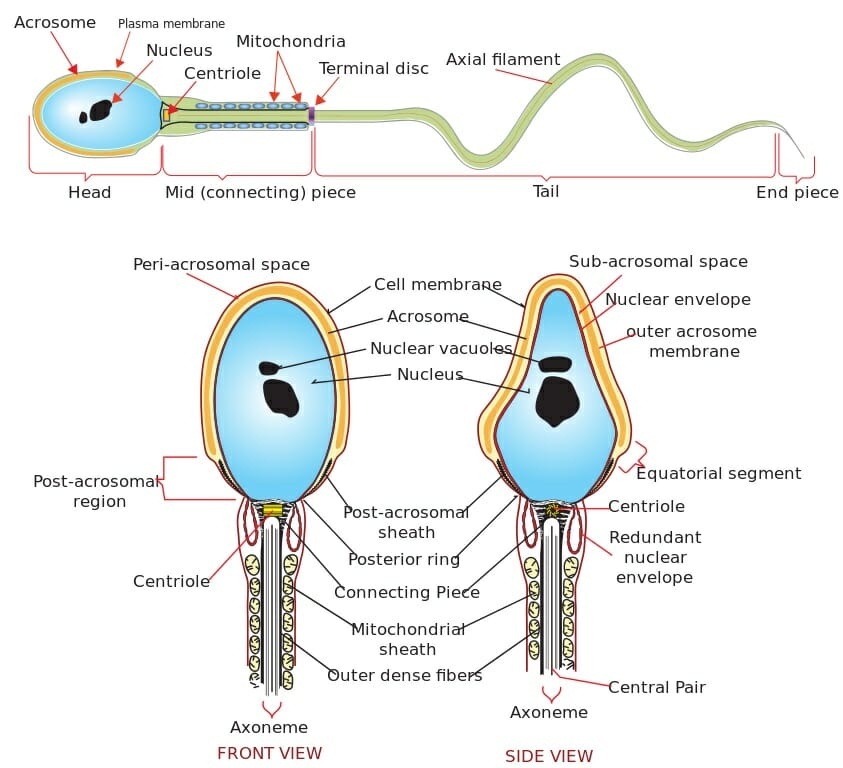Sperm motility is the ability of sperm to move through water during external fertilization or within the female reproductive tract for internal fertilization to reach the egg. Motility also refers to the quality of the sperm motion, meaning that sperm which does not move properly can’t reach the egg and successfully fertilize it. Motility also encompasses the ability of the sperm to penetrate the egg once it reaches it.
Sperm Structure and Movement
A sperm has four main sections: the head, midpiece, tail, and end piece (Figure 1). The head contains the nucleus and is surrounded by the acrosome (cap) and the plasma membrane. The acrosome contains the enzymes the sperm will need to penetrate the surface of the egg. The centriole (which the sperm will donate to the egg upon fertilization) joins the head to the midpiece which has a filamentous core composed of 11 tubules called the axoneme. The midpiece is surrounded by mitochondria that supply energy for the sperm in the form of adenosine triphosphate (ATP).
The tail or flagellum of the sperm is the longest section and the terminal disc separates it from the midpiece. The tail, powered by ATP made by the mitochondria in the midpiece, propels the sperm using a back and forth lashing motion. The motion is created by the rhythmical sliding of the tubules in the axoneme. The end piece contains the axoneme surrounded by the plasma membrane. It is located at the terminus of the tail and tapers down in diameter.
Changes in ion concentration and pH activate sperm movement and the requirements vary by species. For example, in some mammals, an increase in pH and calcium ions activates sperm. The ultimate effect is membrane hyperpolarization which activates the sperm.
The image above shows the detailed structure of a human sperm cell.
Evaluating Sperm Motility
The percentage of motile sperm is the most widely used measurement of semen quality. Normal or acceptable sperm motility varies among species. For example, human sperm motility greater than 50% is normal but only 30% is required in bulls, and as high as 70% is required in dogs. Sperm motility is described as non-motile, progressively motile, and non-progressively motile. Progressively motile sperm swim in a straight line while non-progressively motile means the sperm swim in an abnormal path such as around in circles. Test results usually report the percentage of progressively motile sperm.
There are three main methods for quantifying sperm motility. Some are more accurate than others and require more skill on the part of the operator and/or use more expensive equipment. In a manual motility estimate, a diluted sample of semen is placed on a pre-warmed slide and viewed under a microscope. The operator counts the number of non-motile, progressively motile, and non-progressively motile sperm in at least ten different fields on the slide. From this, an estimate of the percentage of motile sperm is calculated.
Track motility estimates use the same sample preparation as the manual motility estimate. The sperm are photographed using an exposure time of about 0.2 seconds which records their movement on the slide. Progressively motile sperm will leave tracks in a straight line and the non-progressively motile sperm will leave circles or tracks showing some other abnormal path of movement. Of course, non-motile sperm leaves no tracks.
The latest technology involves computer-aided motility analysis. The method is similar to the track motility test, but software detects and tracks the movement of each sperm in the sample and tabulates the data automatically. This method gathers additional data such as the velocity of the sperm and other details about their movement.
References
- Sperm. (2018, May 15). In Wikipedia. Retrieved from https://en.wikipedia.org/w/index.php?title=Sperm&oldid=841448719
- Sperm motility. (2017, August 5). In Wikipedia. Retrieved from https://en.wikipedia.org/w/index.php?title=Sperm_motility&oldid=793978230
- Sperm Motility. (n.d.). Retrieved May 22, 2018, from http://www.vivo.colostate.edu/hbooks/pathphys/reprod/semeneval/motility.html
Sperm Motility

No comments:
Post a Comment